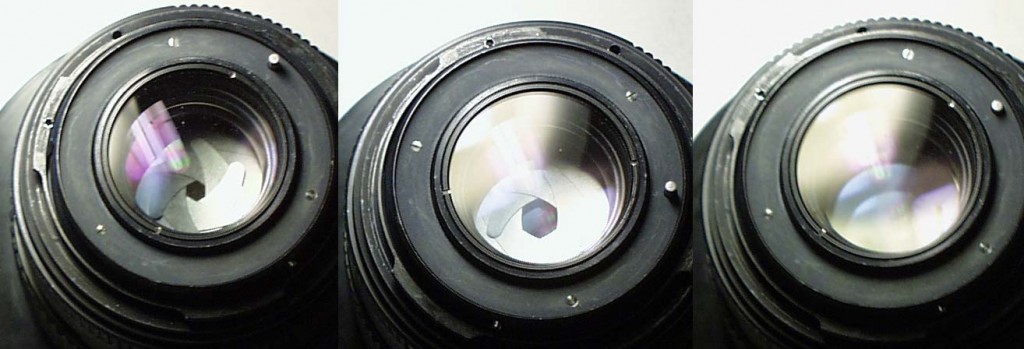Exposure: Aperture
Let’s talk about aperture.
Aperture Mode and What’s aperture?
Lenses let light pass through an aperture. Look at the image below. On the left side you can see a narrow opening, in the middle you see a bigger opening while on the right side you see a complete wide opening.

The size of the aperture determines the quantity of light that will be present in your picture. When the aperture is really big, a lot of light is coming in through the lens and when the aperture is small then less light comes in.
When there is a lot of light coming in, because of a big aperture, then the shutter speed needs to be open for less time otherwise the picture would be overexposed, in other words too bright. On the other hand, if the aperture is small, the shutter speed needs to be open for a longer time so you pictures don’t get too dark.
When you use your camera in the Aperture Priority mode, you can choose the aperture and you camera will do everything else automatically. And, as I just mentioned to you, it is important to have the right shutter speed for the aperture you choose. In Aperture Priority mode, you only choose the aperture and forget about the shutter speed because it is the camera the one that will figure out a proper shutter speed for your aperture.
NOTE: If you have a DSLR, bridge or MILC camera you can set Aperture Priority mode.
If you want to take faster pictures, let’s say for example you want to freeze any type of action such as in sport movements, your pet jumping, kids moving around, people dancing, etc., you need to have a big aperture so more light comes in and the shutter speed needs to open and close at a fast speed. On the other hand, if you want to have some motion blur in those pictures, then you need a small aperture and a slow shutter speed.
Depth of Field
Another thing that happens when adjusting your aperture is something called depth of field. That is, how much is in focus.
Shallow depth of field
With a very large aperture you have a very shallow depth of field. This means that if you focus on a particular object, everything in front and behind that object will be out of focus, it will be blurry. And why would you want that? It is usually to eliminate background distractions and/or create some interesting effects. This is particularly nice if you are shooting a portrait and you want everything behind that person to be blurry. So large aperture gives you shallow depth of field.
Wide depth of field
If you want to take a picture of a garden or landscape and want to have everything in focus at once, you need to do the exact opposite: Use a small aperture and a longer shutter speed. A small aperture gives you a bigger depth of field.
Now you have an idea of how aperture works. I’m going to show you some pictures and you will try to figure out if they were taken with a big or small aperture.
Measuring aperture
Now let’s talk about how to measure the size of the aperture. Aperture is usually written f followed by a number. It is a fraction. F stands for focal length, but you don’t need to worry about what it means. If you have a DSLR camera, a bridge camera, or a MILC camera you will be able to see options with numbers that measure the aperture. Because aperture is measured in fractions, the bigger the number the smaller the aperture. Some big apertures are f/1.8, f/2.4, f/3.5, and f/4. Small apertures are f/16, f/22, f/32
The numbers depend on your lenses. Average small aperture found in lenses may be f/4 or f/3.5. If you want bigger apertures to produce a really shallow depth of field or take pictures under very low light circumstances without your flash, you will need to get different lenses that have f/2.8, f/2, f/1.4, etc. Usually the smaller numbers tend to be the most expensive lenses. For a bridge camera you, of course, have to stick with whatever aperture range your built-in lens has.
I have mentioned some numbers, but you don’t need to know much about math and all that, you won’t do any calculations. You only need to memorize the principle. The smaller the number the bigger the aperture. Or you can also try this to remember: the smaller the number the smaller the depth of field. The bigger the number, the bigger the depth of field. By knowing this principle then you can go from there and play around with these numbers. There is no right aperture number, it all depends on what you are shooting and what effect you want to produce. Don’t think that you have to go either by the biggest or smallest aperture, there’s always in between too. Play with different aperture numbers.
Next let’s talk about shutter speed.
◄ PREVIOUS | HOME | NEXT ►
Latest posts by Jesús Rosas (see all)
- Composition - April 1, 2015
- Exposure: ISO – What Is ISO in Photography? - December 26, 2014
- Exposure: Shutter Speed - December 26, 2014
Pingback: What Is ISO in Photography? » Free photography course and lessons online()
Pingback: Exposure » Free photography course and lessons online()